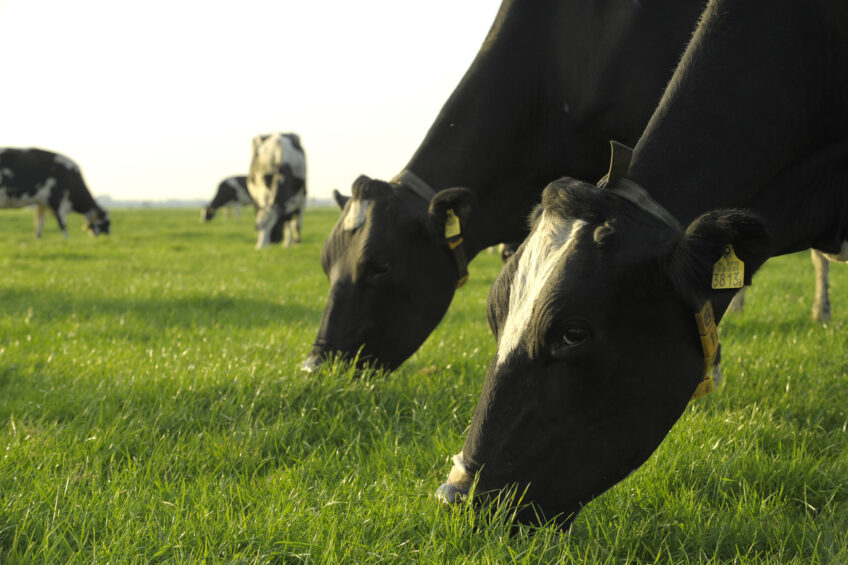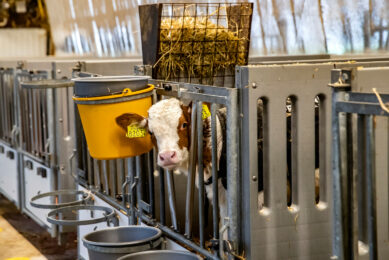Watch the spring nutrient gap

Fresh green grass is a welcome sight come spring. However, early spring grass with limited growth or volume should be approached with caution when it’s used as the sole source of nutrition for recently calved cows.
With limited grass volume, cows can expend more protein and energy than they are taking in and lose body condition. “Cows are also coming out of gestation and into their time of highest nutritional requirement,” says Lee Dickerson, Ph.D. and senior cattle consultant with Purina Animal Nutrition. “While it can be lucrative to turn cows out on pasture at the first sign of grass, short grass won’t supply the nutrients a cow needs to perform her best.”
Providing adequate nutrition helps cows stay in condition, which can in turn help cows get rebred. Rebreeding success will determine the number of calves you’ll have the following year and how much those calves weigh. What are the cow’s requirements coming out of gestation and into lactation? How can you ensure you’re giving her everything she needs?
Needs by the numbers
“Nutritional requirements climb upward from gestation to the last trimester of pregnancy and are at their highest during lactation,” says Dickerson. As a cow begins lactation, her protein and phosphorus requirements go up about 60 to 70% compared to requirements during the last trimester. Requirements for total digestible nutrients (TDN), or energy, increase by an additional 15 to 25%. These nutrients impact milk production, a cow’s ability to get bred back quickly and, ultimately, the resulting calf crop. “If you only maintain your feeding rate from gestation to lactation, you may start shorting your cows of adequate protein and energy. This gap in nutrition can result in lost body condition and performance,” says Dickerson.
What’s at stake?
Research shows that body condition score (BCS) at calving impacts how quickly cows begin cycling and become pregnant. For cows that calved in at a body condition score of 6 (ideal), 98% showed estrus by day 40 of the breeding season, and 90% were confirmed pregnant by day 40. Comparatively, a drop to a BCS 5 resulted in just 80% in estrus and 65% confirmed pregnant. At BCS 4, only 56% were in estrus and 43% were confirmed pregnant. “For every 100 cows, a single point drop from a BCS 6 to a 5 at breeding could equate to roughly 25 calves that are either born later or are not born at all because nutrition slipped post-calving,” says Dickerson. “Calves born later result in less weaning weight.” The amount of energy provided to a cow also influences her milk production and lactation length, which impacts nutrition available for her calf. Research has shown that a cow consuming 170 Kcal per metabolic body weight will maintain peak milk production for approximately 8.3 weeks at 20.2 pounds of milk per day, and will produce 2,726 pounds of milk over the course of 210 days. Providing additional energy, at a level of 290 Kcal per metabolic body weight, resulted in maintaining peak milk production for 10.9 weeks, at 24.2 pounds of milk per day and a total 210-day production of 3,742 pounds.
Set up for spring success
“It’s easy to get excited about a little bit of green grass, but in reality, there may not be enough volume to support a cow’s increasing requirements,” says Dickerson. He emphasises, “Cows will run for green grass and burn more energy searching for grass than what they’ll consume. The energy deficit can result in lost condition.” A visual loss in condition often means you’ve already left some performance on the table. Supplements can help regain condition, but playing catch-up typically means feeding large amounts of supplement at a higher cost. Dickerson recommends providing free-choice hay and supplement early until grass is lush and plentiful. “Offer hay early and continue feeding it long enough for cows to achieve a BCS 6 at calving and no less than a BCS 5.5 at breeding,” says Dickerson. Hay can be complemented with a self-fed supplement containing intake control properties, which allows cattle to decide if they need additional energy and protein. Cows won’t consume much supplement if forage is meeting their requirements, but will consume more supplement if forage is not meeting requirements. “Supplementation can help cows maintain body condition through all seasons and can optimize cow performance with existing forage,” concludes Dickerson.
Join 13,000+ subscribers
Subscribe to our newsletter to stay updated about all the need-to-know content in the dairy sector, two times a week.










